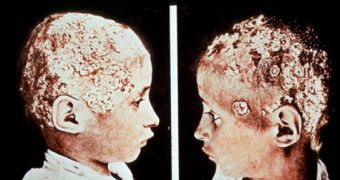All organisms catch infections, from plants to whales. Even some bacteria can get infected.
1.Pathogen microbes are of three types: viruses, bacteria and protozoans. Not all the microbes are infectious. Most bacteria are inoffensive. Escherichia coli from our gut has a role in digestion. Diseases appear when our immune system cannot fight infectious microbes.
2.Viruses can barely be considered alive: they are made of genetic molecules (DNA or RNA) wrapped in proteins. They are exclusively parasite, infecting bacteria, plants and animals. The multiplying viruses kill the host cell.
3.Bacteria are larger; still 500 bacteria are no longer than 1 mm. They have various shapes (sticks, spheres or spirals) and most of them resist to extreme conditions through spores. They live everywhere: soil, air, water and especially dead and decaying organic matters. Some invade and kill directly cells, other by releasing toxins, like Colstridium tetani.
3.Protozoans are unicellular animals, like amoebas. They live especially on water and wet environments, and the largest species are barely visible with the naked eye. Some move using flagella. Amongst the most dangerous are Plasmodium (causing malaria), Trypanosoma (causing sleeping disease) and Amoeba (causing dysentery).
4.There are also multicellular animals causing parasitic disease. Filariasis worms cause elephantiasis and river blindness. The worm called Trichinella enters the body by eating not properly cooked pork or beef, causing trichinosis. The worm Schistosoma causes blood urination and tapeworms and flukes attack the digestive system. Scabies mite lives in the skin. The parasitic diseases are not considered infections.
Instead, fungi infect human skin and mucosae. Tinea causes athlete's foot and mouth and vagina aphthas (white spots) are caused by Candida albicans.
5.The most vulnerable categories to infections are children and elders, those experiencing malnutrition, weakened organisms or which are at the first contact with a germ. Stress, tiredness, exhaustion represent risk factors.
Lack of hygiene, infested food and water, improper sewage and contact with infected persons increase the probability of catching an infection.
6.About 50 % of the infections enter the body through the respiratory ways, by breathing air loaded with mucus containing germs coming from coughing or sneezing of infected persons. Most of these infections, like colds, are not severe, but this is not the case of pneumonia and tuberculosis.
Other microbes enter with the food and water, resisting to the digestive juices and sticking to the walls of the stomach or gut. Such are cholera, typhoid fever and bacterial dysentery.
Contagious infections are transmitted through direct contact skin to skin (like a simple hand shaking or a kiss). The glandular fever is called "kissing disease" as it is believed to be transmitted just through kissing.
Infections transmitted through sex (sexually transmitted diseases) infect genital and urinary ways (but not only), like gonorrhea, syphilis, herpes and HIV.
7.Some microbes have vectors, another animal that carry them from human to human. The Anopheles mosquito transmits malaria, and the bed bugs, the Chagas disease, a type of Trypanosoma in South America.
Cuts and wounds are another entrance gate for microbes, like tetanus bacterium. Other infections can be transmitted from mother to offspring, like syphilis and smallpox.
8.The body has three defense mechanisms: skin, mucosae, sheathing respiratory and digestive ways. Chlorhydric acid produced by the stomach kills numerous germs; antiseptic chemicals are also found in tears. Mucus is also an anti-microbe barrier.
The second defense line is made by white cells, which attack and neutralize or digest microbes. The third defense is represented by the antibodies, proteins that attach to the antigen proteins on the surface of the germs, tagging them for the white cells.
9.When defense systems are overwhelmed, the infection spreads. Acute infections are rapid, in hours or days (like colds). Chronic infections evolve slowly and the first stages are hard to detect. They can persist for years, like TBC and leprosy.
After infection, there is an incubation period, which can be from hours (colds) to years (HIV). Meanwhile, germs multiply, but the person has no symptoms and can infect others too. Then follows the prodomal period, when characteristic symptoms install (like fever or sweating), when a diagnosis can be given.
10.Patients need medical care, resting, warm, proper liquid consumption and healthy food. Antibiotics work against bacteria, while antivirals against viruses. A preventive method is vaccination against viruses.
If a person was infected once with a disease, it can be subsequently protected against it. This immunity appears because white cells remember the structure of the infecting germ's antigen. Next time, they will rapidly recognize them and produce quickly the right antibodies, the germs being neutralized before multiplying.
Vaccines work the same way, by injecting germs (or parts of them) which are dead or weakened. The immune system reacts like in the case of real microbes, but these germs cannot trigger disease. In case of real infections, immunity is already formed. The problem is that many viruses mutate, and so does their antigen. That's why, even if being vaccinated against a strain, a different strain can cause disease. This is common with cold and flue viruses.

 14 DAY TRIAL //
14 DAY TRIAL //